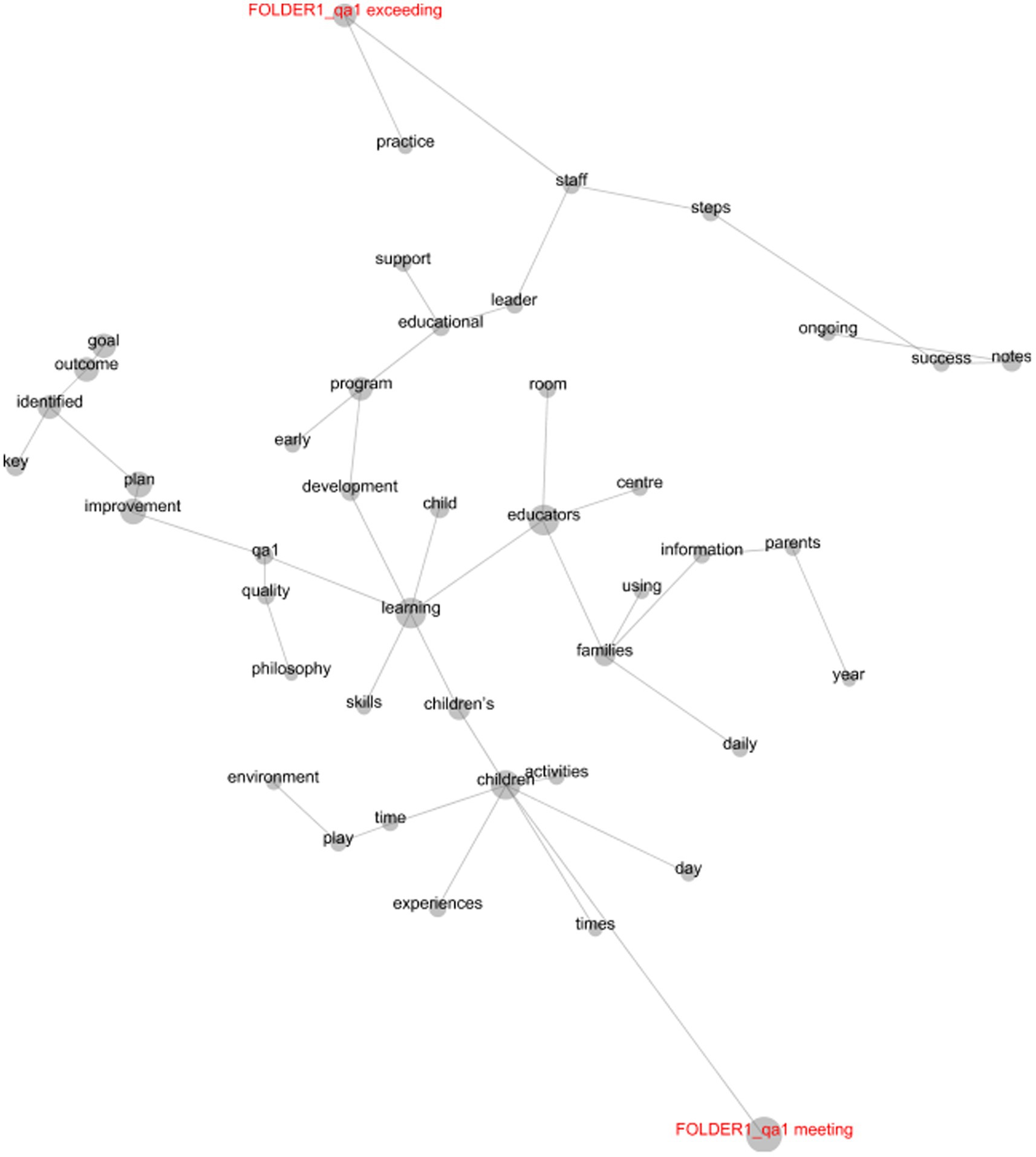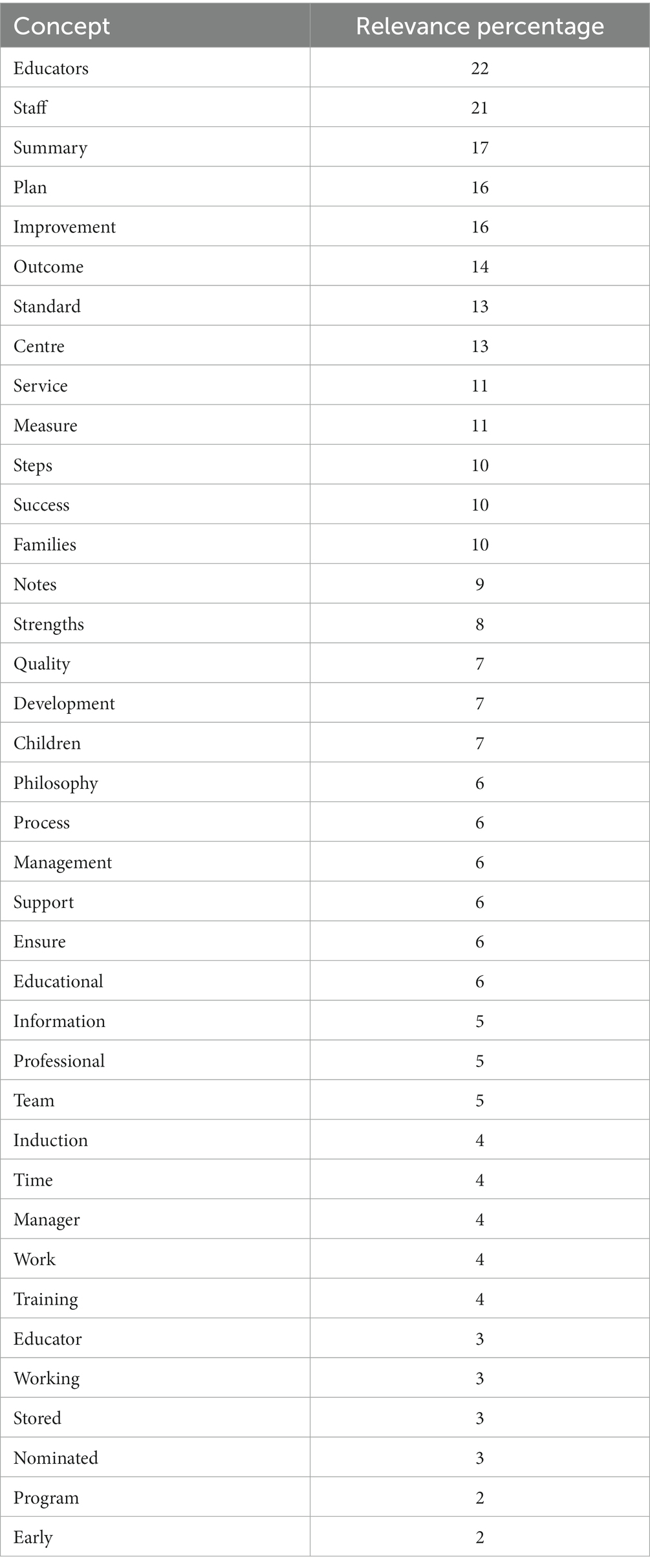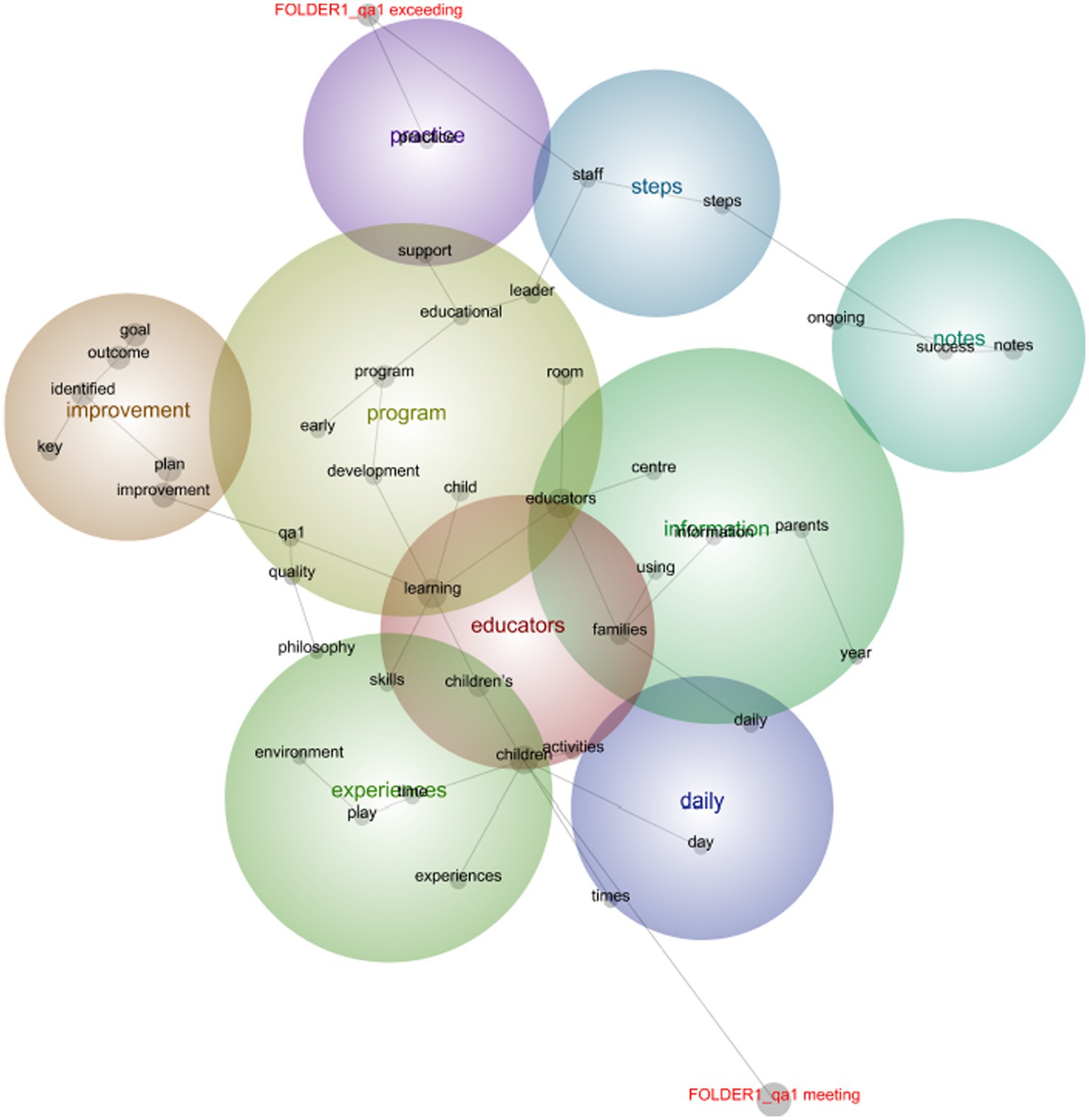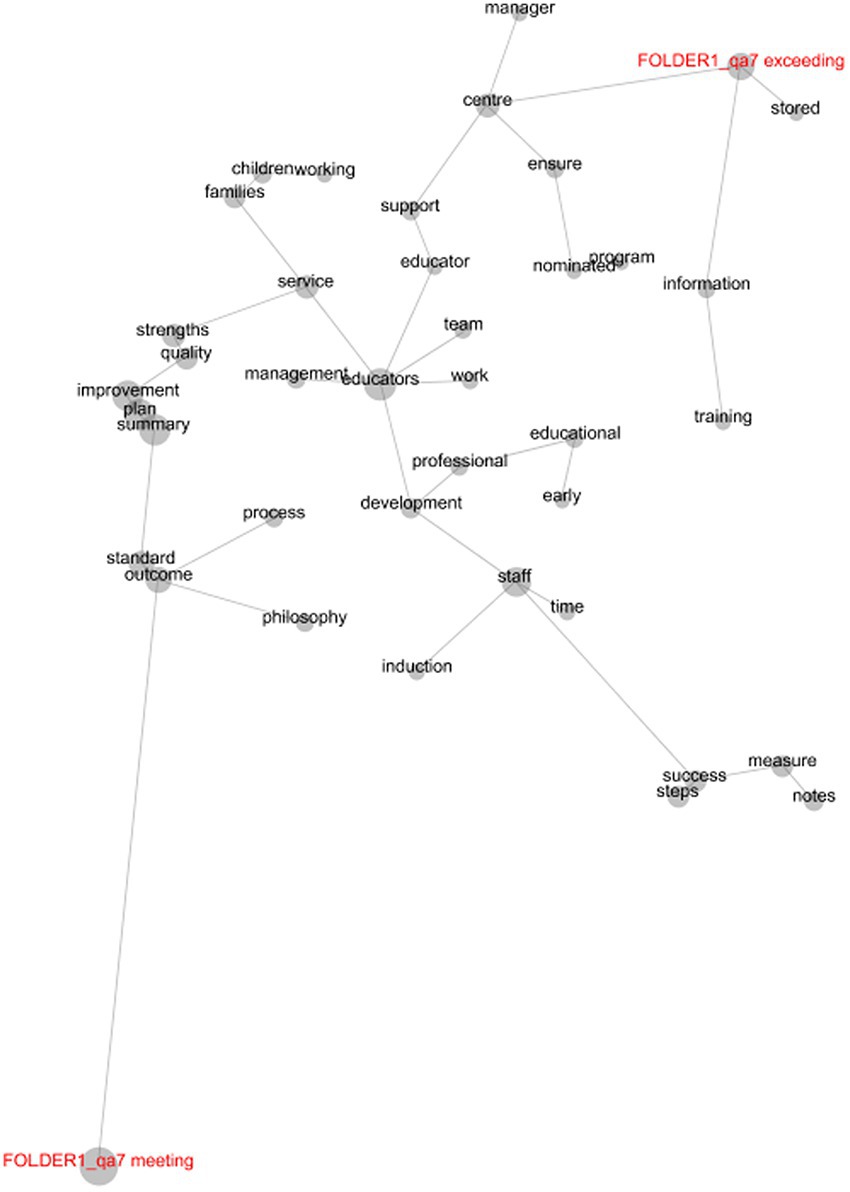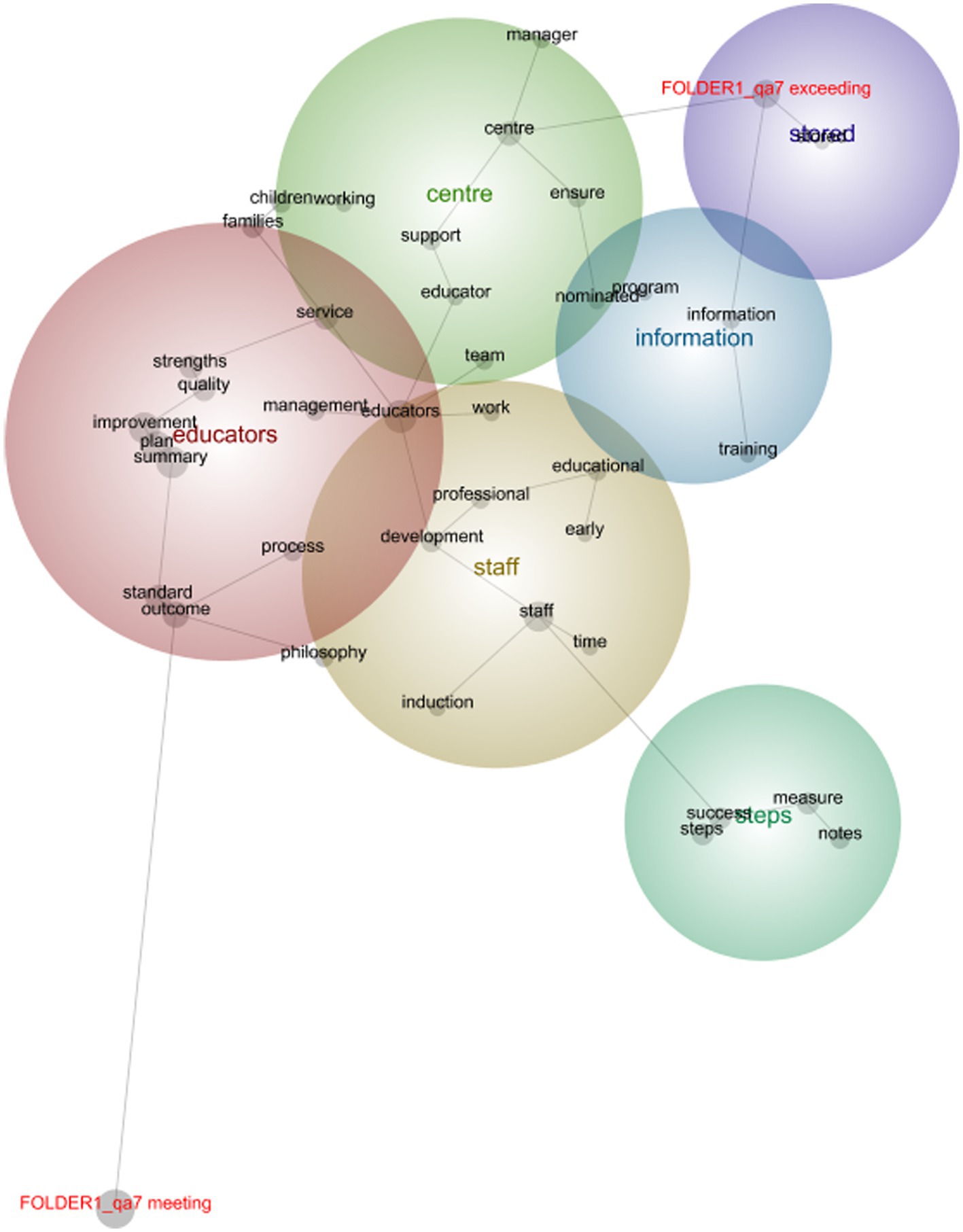Mapping the leap: differences in quality improvement in relation to assessment rating outcomes
- 1School of Education, Macquarie University, Sydney, NSW, Australia
- 2Shanghai Institute of Early Childhood Education, Shanghai Normal University, Shanghai, China
- 3School of Early Childhood and Inclusive Education, Queensland University of Technology, Brisbane, QLD, Australia
- 4School of Education, Edith Cowan University, Joondalup, WA, Australia
- 5Department of Early Childhood Education and Care, University of West Attica, Athens, Greece
Introduction: Australia’s National Quality Standard (NQS) outlines the criteria to assess the quality of early childhood services. A four-point rating scale: (i) Exceeding NQS; (ii) Meeting NQS; (iii) Working Toward NQS; and (iv) Significant Improvement Required is applied to services following a regular assessment and rating process. Settings rated as Working Toward are reassessed within 12 months. Most settings achieved a one-step improvement in this Time 2 reassessment, moving to a Meeting rating but some settings made a two-step improvement, moving to an Exceeding rating. The QIP is a key document used by authorities to assess the quality of a service.
Methods: A grounded theory, data driven approach was taken to deepen understanding of quality rating improvements in long day care services in Australia of quality rating improvements by early childhood education and care [ECEC] services in Australia. This study, part of the second phase of a three phase study involved a document analysis of the Time 2 Quality Improvement Plans (QIPs) of a representative sample of Long Day Care (LDC) services (n = 60) from all Australian states and territories to determine what factors may have contributed to these different levels of improvement, with a focus on Quality Area 1 (QA1) (Educational programs and practices) and Quality Area 7 (QA7) (Governance and leadership). The study utilized the semantic analysis tool Leximancer 4.5. Leximancer 4.5 statistically analyses the semantic relationships between concepts in documents by measuring word proximity and correlation. The software creates visual maps of concepts and their connections to each other in texts. Concepts located near one another on the map are more likely to be contextually related. This tool is particularly useful when there are multiple, complex documents to analyze, reducing the potential biases that can arise from documents that use language with which these researchers are very familiar with.
Results: The analysis found clear differences between the Time 2 QIPs of services who had made a two-step rating improvement and those who made a one-step improvement. Two-step (Exceeding NQS) category improvers for QA1 placed attention in their QIPs on improvement to the program and overall practice, with an orientation to the role of the educational leader. Two-step (Exceeding NQS) category improvers for QA7 seemed to be more oriented to a systemic view of the processes encompassed by QA7; how the management of the service and information supports the work of educators, with stronger links made between leadership roles (the manager and nominated supervisor) and the work of educators.
Discussion: The QIPs demonstrated how the intentional and systemic processes in these quality areas related to practice, management, and leadership.
1. Introduction
This paper reports on the second phase of a larger study commissioned by the Australian Children’s Education and Care Quality Authority [ACECQA] in 2018 (Harrison et al., 2023) where the focus was on the small but significant number of LDC services achieving a two-step improvement in an overall quality rating after receiving a Working Toward rating in a first assessment. The intention was to develop an understanding of how these LDC services differed from those who had made a one-step improvement only. We present the findings of a qualitative analysis, using the conceptual analysis tool Leximancer 4.5 (Leximancer, 2018a,b) of the Quality Improvement Plans (QIPs) of 60 LDC services selected through proportionate stratified random sampling in the initial phase of the study (Harrison et al., 2023), as representative of LDC in Australia. Harrison et al. (2023) explained this focus in the protocol paper for Phase 1 of this research as “While all seven QAs contribute to overall quality, QA1 Educational program and practice is recognized as “the most critical to longer term child outcomes” (Australian Children’s Education and Care Authority [ACECQA], 2016, p. 40) and QA7 Governance and leadership as “central” to all quality areas because “the way a services addresses the NQS will be directly influenced by the quality of its leadership and management” (Australian Children’s Education and Care Authority [ACECQA], 2017, p. 47).” The analysis sought to investigate the features and plans which contributed to Quality Areas (QAs) 1 and 7 improvements.
1.1. Research context: the Australian QRIS system for ECEC
Australia has a national system for regulating the quality improvement for early childhood education and care (ECEC) across all states and territories in the federation (Council of Australian Governments [COAG], 2009; Sims et al., 2017). ACECQA is the national body that supports governments in administering the National Quality Framework (NQF) and the National Quality Standard (NQS) (Australian Children’s Education and Care Authority [ACECQA], 2012, 2020) for children’s education and care. ACECQA works with Australian State and Territory governments to work with states and territories to operationalize the national assessment and rating process; lead the two national Approved Learning Frameworks which guide educational programs and practices in ECEC and OSHC and drive continuous quality improvement in education and care (Australian Children’s Education and Care Authority [ACECQA], 2023).
The NQS creates benchmarks for ECEC practice, comprising seven QAs designed to meet outcomes for children.
The seven QAs, as listed in the ACECQA website are:
1. Educational program and practice
2. Children’s health and safety
3. Physical environment
4. Staffing arrangements
5. Relationships with children
6. Collaborative partnerships with children and families
7. Governance and leadership (Australian Children’s Education and Care Authority [ACECQA], 2020).
While all seven QAs contribute to overall ECEC service quality, QA1 Educational program and practice is recognized as “the most critical to longer term child outcomes” (Australian Children’s Education and Care Authority [ACECQA], 2016, p. 40) and QA7 Governance and leadership as “central” to all quality areas because “the way a service addresses the NQS will be directly influenced by the quality of its leadership and management” (Australian Children’s Education and Care Authority [ACECQA], 2017, p. 47).
An overarching aim of the NQS is to “raise quality and drive continuous improvement” (Australian Children’s Education and Care Authority [ACECQA], 2020, p. 8), and engagement with the NQS assessment and rating (A&R) process is a critical component of this system. Services enter a process of preparation for this assessment through collective self-reflection and the development of a Quality Improvement Plan [QIP] (Australian Children’s Education and Care Authority [ACECQA], 2020). The aim of the QIP is to enable services to “self-assess their performance in delivering quality education and care and to plan future improvements” (Australian Children’s Education and Care Authority [ACECQA], 2012, p. 34). The QIP is included in the A & R process, as ECEC services are required to submit their QIP to the regulatory authority and this is used to support the A &R process.
Services receive a rating for each QA and are awarded an overall service rating. According to the ACECQA website, there are four possible ratings that can be achieved after an A&R visit (from the highest): “(i) Exceeding NQS; (ii) Meeting NQS; (iii) Working Toward NQS; and (iv) Significant Improvement Required” (Australian Children’s Education and Care Authority [ACECQA], 2020). A further rating – Excellent – the highest possible rating – can be achieved by services rated as ‘Exceeding’ in all QAs, through an additional application process administered through ACECQA. Receiving a Working Toward NQS rating means the service will be reassessed in 12 months (Australian Children’s Education and Care Authority [ACECQA], 2018). Australian Children’s Education and Care Authority [ACECQA]’s (2018) examination of Australian ECEC services that were assessed against the NQS between 2013 and 2017 found that over 60% of childcare centres and over 80% of preschools that were initially rated as Working Toward were able to demonstrate improvements.
1.2. Literature review
1.2.1. Impact of quality in ECEC
Internationally, it has been recognized that the quality of care and education in early childhood has significant positive benefit across the lifespan (Organisation for Economic Cooperation and Development [OECD], 2015). During the last 10 years, Australian governments at the nation and state/territory levels and the ECEC profession have been concerned with ongoing quality improvement. These improvements need to address both structural and process elements of service function. The NQF, has specifically targeted establishing consistent national quality standards (Torii et al., 2017).
The core activity of ECEC is the design of learning environments that support relationships, interactions and learning for all children (Cloney et al., 2016). It is concerning however that QA1, ‘Educational program and practice’ is the quality area services are most likely to rate poorly against (Australian Children’s Education and Care Authority [ACECQA], 2017). To improve quality across ECEC, supports that strengthen early childhood educator skills, knowledge and interactions must be a core focus (Torii et al., 2017). The workforce crisis in ECEC, intensified amidst the stresses imposed by the COVID-19 pandemic (McFarland et al., 2022), with persistent issues around poor remuneration, low public and political recognition of the value of ECEC and consequent low staff satisfaction and poor retention, has inhibited quality improvement (Irvine et al., 2016; Cumming et al., 2021).
1.2.2. Role of leadership in quality
Leadership and management of ECEC services are recognized as critical to quality care experiences and education outcomes for children. QA7 was developed in recognition of this (Australian Children’s Education and Care Authority [ACECQA], 2020). Historically there has been concern that few ECEC leaders have formal leadership training, despite the demands for leadership placed upon them (Hard and O'Gorman, 2007; Rodd, 2013; LeeKeenan and Ponte, 2018). Halttunen et al. (2019) examined practices relating to pedagogical leadership across three different countries and impact of leadership on pedagogy and quality in ECEC settings, finding that ECEC leadership roles are complex but poorly defined and heavily reliant on individual context arrangements, with heavy administrative and compliance responsibilities that needed to be balanced against pedagogical leadership and relationship development. While there are models for developing leaders in the school system there is limited consistent practice or a commonly held model of leadership in ECEC (Aubrey, 2019).
Mathers et al. (2012) found the quality of a service is dependent upon the direct interactional experience of children in ECEC with educators who have skills and expertise to provide appropriate guidance and support their learning. This is supported by other research emphasizing the crucial role of qualifications for leaders and their role in developing and supporting relationships with other educators, children, and their families (Howes et al., 2008).
2. Materials and methods
This research was part of the second phase of a three-phase study, aimed at investigating what factors contributed to improving quality in QA1 and QA7 of the NQS, given that ECEC services tend to rate lower against QA1, and the critical importance of both quality areas for child outcomes in ECEC.
Grounded theory was deemed as a suitable approach to this research. There is very limited research specifically investigating QA1 and QA7 in the Australian ECEC context. The QIPs were effectively qualitative data. We followed the principles of grounded theory encompassing looking for concepts, categorizing these and discovering theme as they emerged from the data (Glaser and Strauss, 1967). Grounded theory was developed to create theories that were empirically driven from real-world situations (Glaser and Strauss, 1967). It was a methodology that emerged because it was understandable by practitioners and would work in real life situations. Data gathering and data analysis are simultaneous in grounded theory. Grounded theory uses both inductive (theory generation) and deductive (theory testing). There are four key components of grounded theory incorporating theoretical sensitivity; constant comparison; theoretical sampling and theoretical saturation which are used in combination to develop theory from the data (Corbin and Strauss, 2008). Glaser and Strauss (1967) suggest theoretical sensitivity is based on familiarity with sociological theories and concepts alongside professional experience. As academics at university, we have a range of expertise and understanding of theories as well as our experience as early childhood teachers and educators. Constant comparison is about comparing cases in our data which were the QIPs from individual ECEC services to look for commonalities that emerged for quality improvement where conceptual categories were specified and described. Importantly, this cannot be determined in advance. Theoretical saturation occurs when no new concepts can be seen in the data which is the point of saturation. These components work together as we first used the discovery process enabled by Leximancer 4.5 (Leximancer, 2018a,b) as we explored the factors enabling change. We followed the principle by focusing on this broad research focus question: What factors enabled quality improvement in QA1 and QA7? (Glaser and Strauss, 1967; Glaser, 1978; Charmaz, 2006; Urquhart, 2013).
Documents are important sources of data for researchers as vehicles of records, thinking and social expression (Bowen, 2009; Wharton, 2011). Traditionally a source of data for historical research, documents relevant to the contemporary context for their record of societal and institutional values are an important source for critical reflection on policy and practice (Sumsion and Wong, 2011). A common critique of reports of document analysis is that the process of document selection and analysis is not explicit, the credibility, relevance and procedures and tools for analysis need to be clearly explained (Bowen, 2009; Wharton, 2011). As noted above, the QIPs are documents that describe the reflective process of the service, as they document the practices of the service and changes identified as needed to support continuous and ongoing quality improvement. As such they are an important source to develop an understanding of the process and focus for quality improvement in the services included in the analysis.
2.1. Data
A representative sample of 60 LDC services was selected for Phase 2 based on the findings of the first phase of the study (Harrison et al., 2023). De-identified copies of QIPs from 60 LDC services were provided by ACECQA. Leximancer 4.5 (Leximancer, 2018a) was used to conceptually analyze this data, as we sought to determine what patterns of thinking and reflection may emerge from the QIPs that supported quality rating improvement.
2.2. Data analysis
2.2.1. Leximancer 4.5
Leximancer 4.5 (Leximancer, 2018a,b) is a qualitative, conceptual, and relational analysis tool. It can be used to efficiently and systematically analyze large amounts of natural language texts, producing reliable, reproduceable results, based on its measurement of the occurrence and co-occurrence of words in text (Smith and Humphreys, 2006; Angus et al., 2013). Researchers can manually refine the automated process to suit their research interests and purpose. Leximancer reduces the need for manual handling of data, when compared to other software used to code and manage qualitative data, such as NVivo (Sotiriadou et al., 2014).
Leximancer is being used across a growing range of research areas where natural language is being studied, particularly where large amounts of text might be under analysis. Initially used by mainly business researchers, to understand conceptualizations of social responsibility by mining companies in annual reporting (Parsons and McKenna, 2005) for example, it has been extensively used by news and social media analysts to consider patterns of reporting (Spry and Dwyer, 2017), trends in opinion (Carah et al., 2016; McKenna et al., 2017) and image development (Tseng et al., 2015). Academic researchers have used Leximancer to investigate conceptual development in a range of academic fields: the history of ideas within a single journal (Rooney et al., 2011) and the development and use of terms: accountability in accounting (Crofts and Bisman, 2010) and corporate environmental performance (Poser et al., 2012). Analysts of educational policy and curriculum have also made use of the application to consider how concepts have developed and shifted in the process of document drafting (Millei and Sumsion, 2011), make conceptual comparisons in curriculum documents in different jurisdictions (Hyndman and Pill, 2018), explore how curriculum documents may or may not be explicit about attitudes and practices (Davis and Dunn, 2018) and how policy and curricula impact particular interest groups, rural communities and schools (Roberts, 2017). Groups of documents can be analyzed as categorized files to explore different relationships (Leximancer, 2018b): Roberts (2017) used the group file clustering or tagging capacity of Leximancer to explore where categories of participants stood in relation to particular themes and concepts, finding that demographic differences (for example age, time in community or relative isolation of community) influenced concerns and attitudes participant teachers had to recent curricular changes.
Leximancer’s discovery process supports the development of an initial sense of the data and guides subsequent enquiry, without any direct intervention by the researcher, so aiding a grounded theory analysis of the data (Angus et al., 2013; Leximancer, 2018a,b). Leximancer uses blocks of text and the co-occurrence and frequencies of words in a text to develop thematic clusters, described as ‘concepts’ (Angus et al., 2013; Sotiriadou et al., 2014; Leximancer, 2018a,b). This is presented visually in a concept map, where the connections between concepts and their importance in the data are illustrated. While the analysis has a statistical basis, the need to interpret the map in the context of the texts the data is drawn from means the final analysis of the data is more qualitative (Angus et al., 2013).
The QIPs (n = 60) that were investigated in this project were all grounded in the NQS, and all had a great similarity in their language as a result. Simultaneously they were also idiosyncratic documents, individual to each of the services who developed them. A particular feature of Leximancer, and its key advantage as an analytical tool in this instance, is its capacity to cut through the similarity of language in documents and find the underlying subtleties and nuances of meaning and thinking that differentiate different groups of documents from each other (Angus et al., 2013; Hyndman and Pill, 2018). The language of the NQS, further, was very familiar to us as researchers in early childhood in Australia, so Leximancer provided a valuable bracketing function, a feature noted by other ECEC researchers (Millei and Sumsion, 2011).
2.3. Leximancer 4.5 analysis of QIPs
2.3.1. Document preparation prior to Leximancer 4.5 analysis
The deidentified QIP documents provided were presented in a range of formats, including plans and reflections about all the QAs. Most were tabulated but others were descriptive prose. We needed to extract the relevant data (for QA1 and QA7) and following advice from an experienced Leximancer user, we eliminated all extraneous formatting and converted all the relevant text into *.txt files to create document uniformity and compatibility with the application (Angus, 2014; Figure 1). Small typographical errors were also amended at this stage to ensure spelling, for example, was correct and consistent across all the documents. Each QA was analyzed separately.
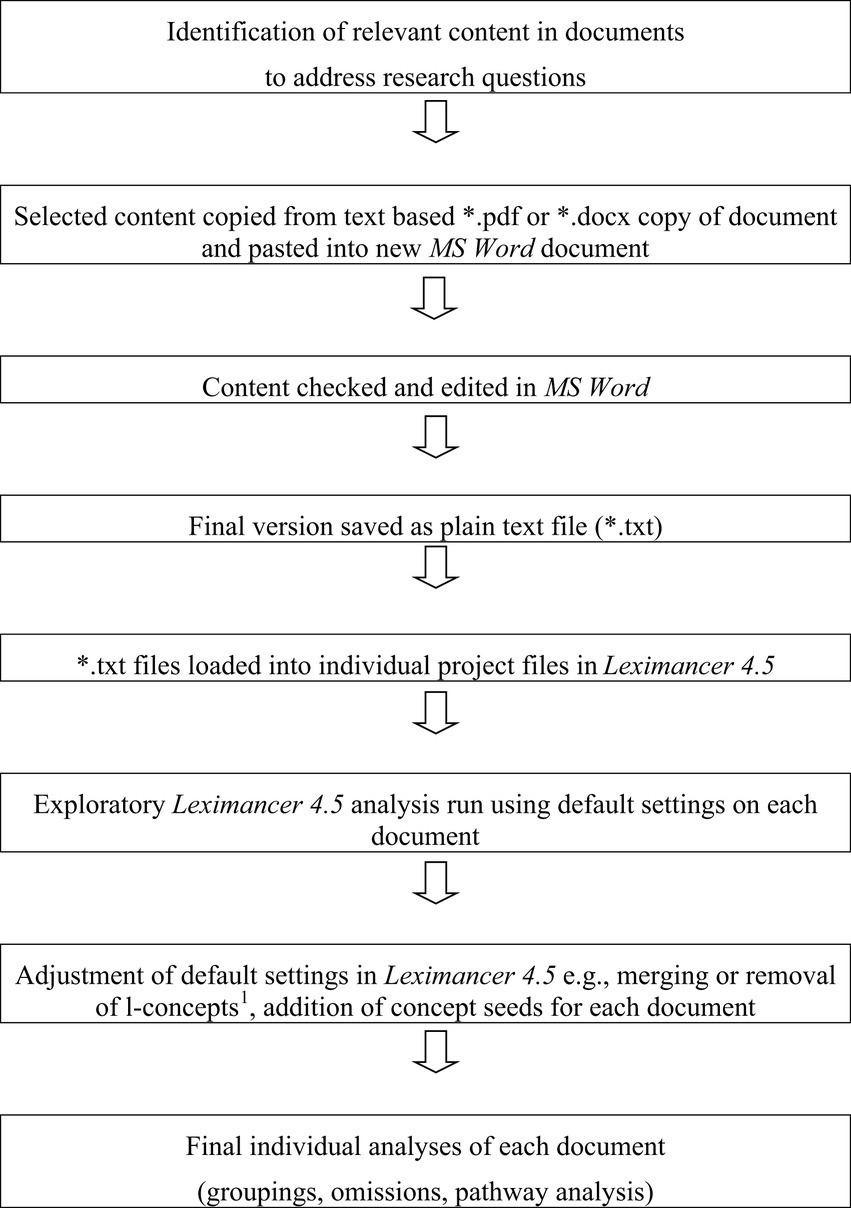
Figure 1. Flow chart of document preparation and analysis procedure steps. 1 l-concept: concept identified by Leximancer, represented by a node on the concept map. We used this term in our research group communications to distinguish concepts identified by Leximancer from a more general use of the term concept.
2.3.2. Document analysis
Some adjustment was made to concept labels to refine and support analysis following an initial analysis of the documents on default settings. We refined the analysis by requiring the software turn off “name-like concepts” (Leximancer will identify nouns used at the start of a sentence or in the text with a capital letter as a proper noun) (Leximancer, 2018b). Adjustments to ensure the inclusion of concepts including leadership for the QA7 analysis and philosophy for the QA1 analysis were made. These were found to be concepts with quite low order relevance in both the texts and their positioning and relationships to other concepts but were of interest to the research. This may seem extraordinary, given the nature and content of the QAs under analysis. We have often found though that these primary ideas are sometimes rarely mentioned directly in documents, where they are ideas that operate as a sub-textual theme that is assumed. Subsequently, educational and leader were added as new concept seeds, as were professional and development, also to identify concepts that did not arise clearly in the default analysis. We also noted slight variances in the way service names had been de-identified. We merged all these combinations and re-labeled them as service name to refine the map and increase clarity.
The files were then grouped into two categories for each QA, one file for those QIPs from services who made a one-step rating improvement at the Time 2 A&R (from Working Toward to Meeting the NQS) and one file for those QIPs from services who made a two-step rating improvement at the Time 2 A&R (from Working Toward to Exceeding the NQS). This categorization supported our developing understanding of the differences between these two groups. The positioning of the groups on each map in relation to each other, core concepts and themes and the mapped pathways between concepts were considered in each case.
3. Findings
The Leximancer 4.5 analysis demonstrated some clear differences between Time 2 QIPS developed by one-step (Meeting NQS) category services and two-step (Exceeding NQS) category services across both quality areas.
3.1. Findings for Quality Area 1
The mapping of the Time 2 QIPs for Quality Area 1 found children’s learning alongside educator skills were emphasized in plans for improvement in this quality area, as indicated by the central position and co-location of these concepts in the map (Figure 2). Direct pathways are evident between children, learning, educators, and skills. These concepts are at the core of all the QIPs analyzed. These concepts all share a similar relevance in the document at between 29 and 27%, as shown in Table 1. The importance of these concepts is visually demonstrated by the central positioning of quite large nodes in the map, as shown in Figure 2. This suggests that QIPs developed for QA1 share a similar primary focus on children’s learning and the work of educators in relation to that.
Concepts related to the ‘boiler plating’ (or structural elements) of the template are evident in the incidence of concepts such as notes, goal, outcome, key, plan and identified. While these are important structurally to the QIPs and explain purposes for different activities related to the QIP process, the very peripheral positioning of these concepts demonstrated that while they are of some importance, they are not a matter of central concern. Of greater interest were the range of concepts relating to the program and planning, such as experiences, time, development and the environment. These concepts were clustered around the core concepts of children and learning, close to concepts relating to staff, children and families. This would seem to indicate the consideration of the range of stakeholders and their potential contribution to children’s learning in the development of the QIPs.
3.1.1. Thematic importance
The heat mapping of the themes shown in Figure 3 and Table 2 speaks to the priorities of the QIPs overall and amongst the improvement services. The role of educators and the experiences of children was critical across all the documents but were of greater concern, it would seem, to services that made a one-step improvement to Meeting NQS. Services that made a two-step improvement to Exceeding NQS placed greater emphasis on the program, also a high-ranking theme across the documents in total, but ideas associated with practices, improvement and steps were more explicit in the Exceeding QIPs.
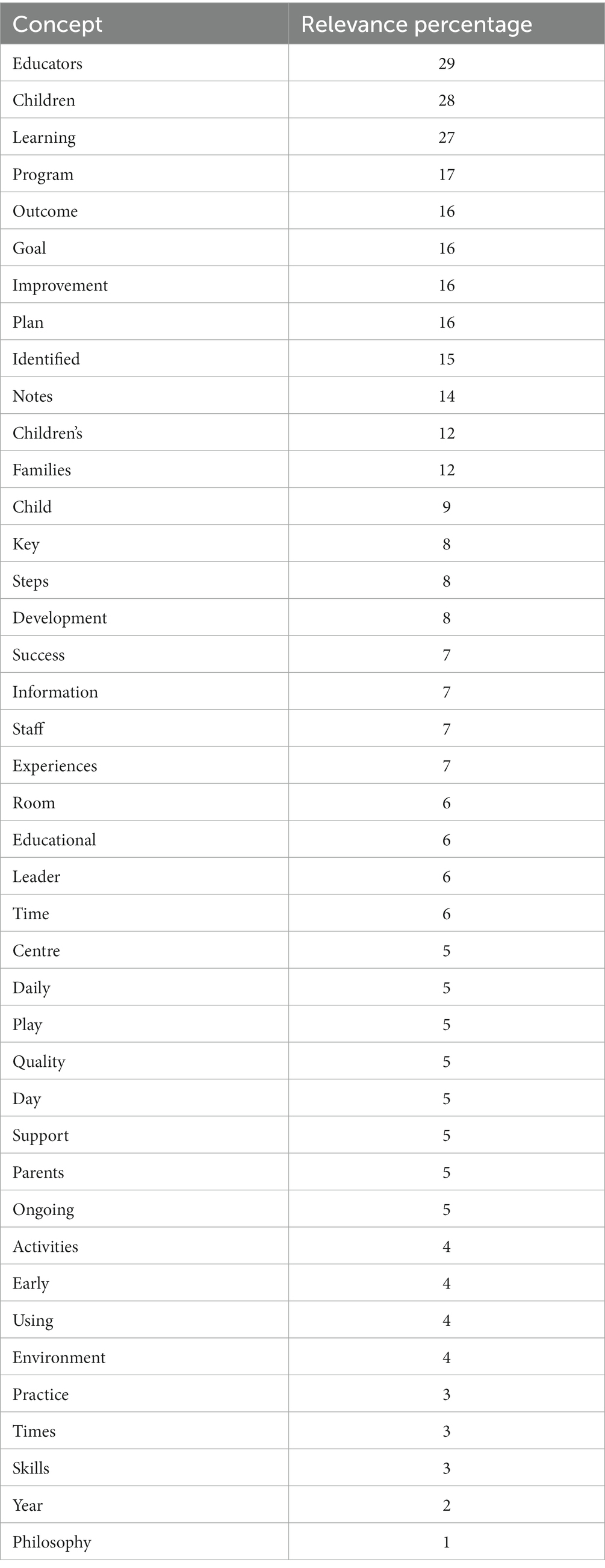
Table 2. Leximancer 4.5 analysis of QIP Quality Areas 1 extracts, concepts and relevance percentage.
3.1.2. Comparison between one-step (meeting NQS) category and two-step (exceeding NQS) category QIPs for QA1
The comparative analysis undertaken by tagging the one-step (Meeting NQS) category and two-step (Exceeding NQS) category QIPs was revealing. The location of nodes labeled FOLDER1_qa1 meeting and FOLDER1_qa1 exceeding shows how the two categories of services compared with each other (Figure 4). The size of the nodes on the map for each folder is only an indication that more services were in the one-step (Meeting NQS) category and there were fewer in the two-step (Exceeding NQS) category. The diametric positioning of the folder nodes on the maps demonstrates significant differences between the QIPs in these different categories.
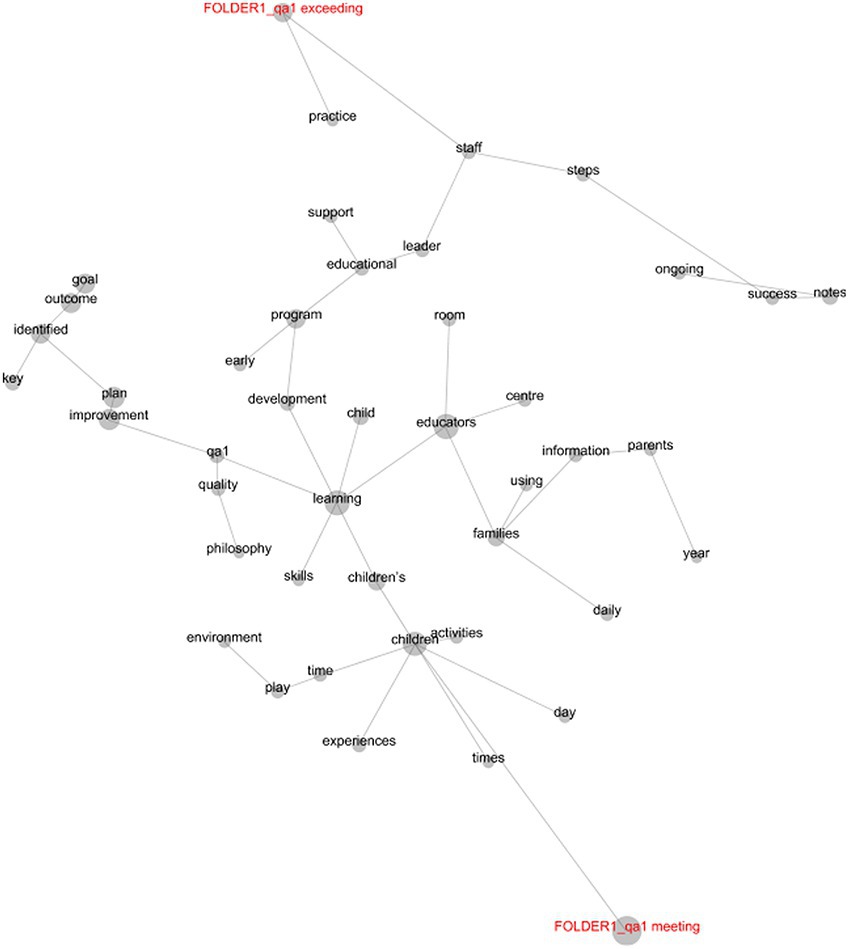
Figure 4. Concept map with highlighted conceptual pathways: comparison of one-step and two-step improvement services for Quality Area 1.
Firstly, the proximity of the Folder nodes in relation to the overall map was of interest (Figure 2). The Exceeding services are quite close to the map itself, with direct conceptual connections to staff and practice. The folder node for the Meeting services is however at some distance from the overall map. This suggests that Exceeding services’ QIPs were quite closely aligned with the ideas the QIPs explore overall. The node representing the collected Meeting QIPS is at a clear distance from the map overall, with a direct conceptual link to children, suggesting that there was a more superficial connection with the ideas the QIPs explore overall (Table 3).
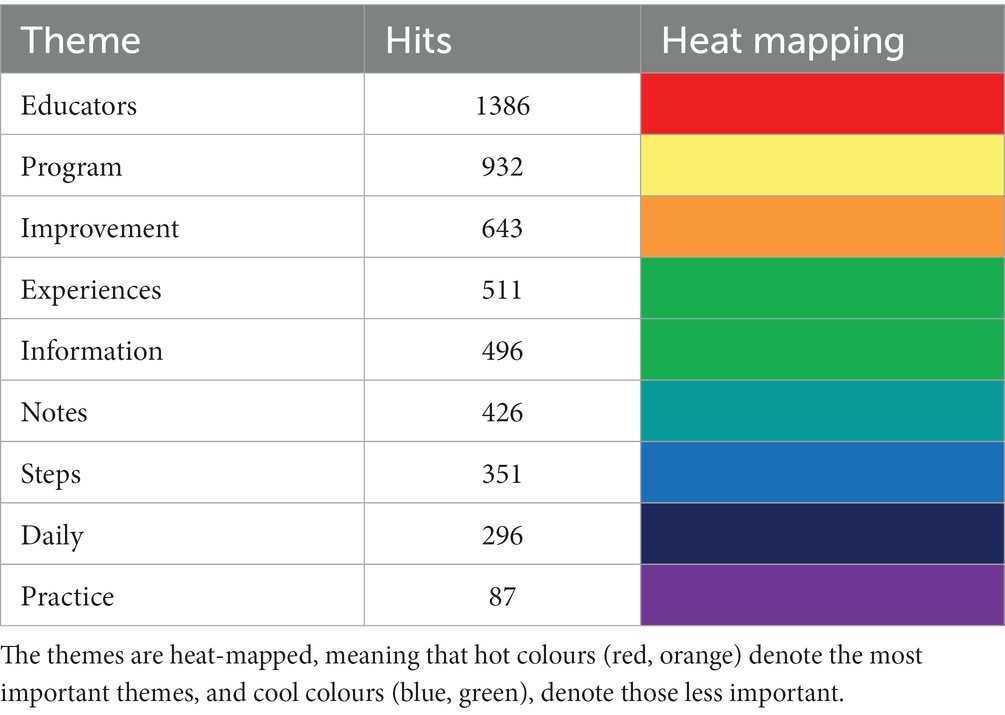
Table 3. QA1 thematic synopsis of one-step and two-step (Exceeding NQS) category improvement services.
Secondly, the colocation of the folders with themed clusters of concepts was revealing (Figure 3). Services that improved one step seem to have emphasized the daily routines and experiences of the children within the environment (summarized by the themes experiences, daily and educators) (Figure 3). Services that improved two steps placed attention on improvement to the program and practice. The educational leader role is located within the program theme and directly connected semantically to staff, support and program. Program itself was directly linked to development and learning, then to children’s and children (Figure 3).
We then explored the conceptual pathways between some key concepts. Concepts may be located close to one another on the map but are not always visually represented as connected by drawn pathways. The pathways indicate nuanced connections between ideas. One-step (Meeting NQS) category QIPs (blue lines), who focused attention on the daily experiences of children, demonstrated a quite scattered focus on a range of individual considerations for planning and programming (Figure 4). Two-step (Exceeding NQS) category QIPs (red lines), conversely, focused on educational leadership (Figure 4). Such a focus indicated a commitment to providing time and support to develop programs and support staff in ways that went beyond a reactive approach. This recognition of the role of the educational leader to drive improvements in children’s learning experiences appeared to demonstrate a deeper level of understanding of what may contribute to positive child outcomes and service excellence (Figure 5).
3.2. Findings for Quality Area 7
The mapping of the Time 2 QIPs for QA 7 found that educators, management, and professional development were placed in a central position on the concept map, close to one another, demonstrating a consciousness of the relationship between these ideas and high quality ECEC (Figure 3). These concepts are at the core of all the QIPs analyzed for QA7.
The core concepts in the QIPS for QA 7 centred on educators and staff. The use of these two concepts suggests that there is a distinction drawn between educators and other centre staff in different roles, but at times it is a catch-all phrase for all adults working in the service. These concepts share a similar relevance in the document at between 22 and 21%, as shown in Table 1. The importance of these concepts is visually demonstrated by the central positioning of quite large nodes in the map (Figure 3). This suggests that QIPs developed for QA7 share a similar primary focus on the role of educators and people working in the service.
Concepts related to the ‘boiler plating’ of the template are evident again in the incidence of concepts such as outcome, improvement, plan, steps and standard. These were important structurally to the QIPs and explained purposes for different activities related to the QIP process, while they are relatively peripheral, they are quite closely co-located with concepts including educators and management.
3.2.1. Thematic importance
The heat mapping of the themes shown in Figure 6 and Table 4 again speaks to the priorities of the QIPs amongst all the improvement services. While one-step (Meeting NQS) category QIPs were concerned with educators and staff, both very important concepts across all the QIPs analyzed, two-step (Exceeding NQS) category QIPs were more focused on supporting staff at all levels in the service, notably through strategies designed to enable staff to engage in professional learning for QA 7. One-step (Meeting NQS) category services seem to have followed the template very closely, alignment with standards and outcomes was emphasized. This is in contrast to QA 7 two-step (Exceeding NQS) category services whereby educators were supported by management structures and roles.
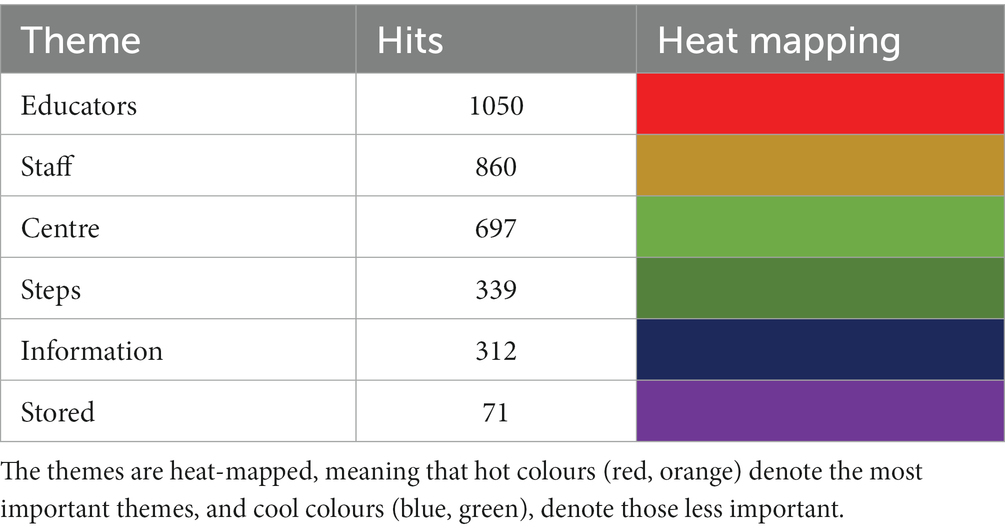
Table 4. QA7 thematic synopsis of comparison of one-step and two-step (Exceeding NQS) category improvement services.
3.2.2. Comparison between one-step (meeting NQS) category and two-step (exceeding NQS) category QIPs
The differences between the one-step (Meeting NQS) category and two-step (Exceeding NQS) category QIPs and the concepts of greatest relevance in their QIPs was evident in the percentage relevance of important concepts in the two-step improving QIPs, such as support, manager, and training, which were all ranked at less than 10% relevance (Table 1). This is reflective in part by the lesser number of two-step (Exceeding NQS) category QIPs in the sample but also that these ideas were clearly important in these QIPS.
The location of nodes labeled FOLDER1_qa7 meeting and FOLDER1_qa7 exceeding (Figure 7) shows how the two categories of services relate to each other. The size of the nodes on the map is an indication that, again, more services were in the one-step (Meeting NQS) category. The diametric positioning of the folder nodes again on the maps demonstrates significant differences between the QIPs in these different categories. Like the findings for QA1, the node for FOLDER1_qa7 meeting is at an even more pronounced distance from the overall map. This is not to suggest that the ideas in the QIPs are not present or developed by one-step improvers, only that in comparison to the two-step (Exceeding NQS) category, there seems to be less developed and explicit responses and planning in the QIPs.
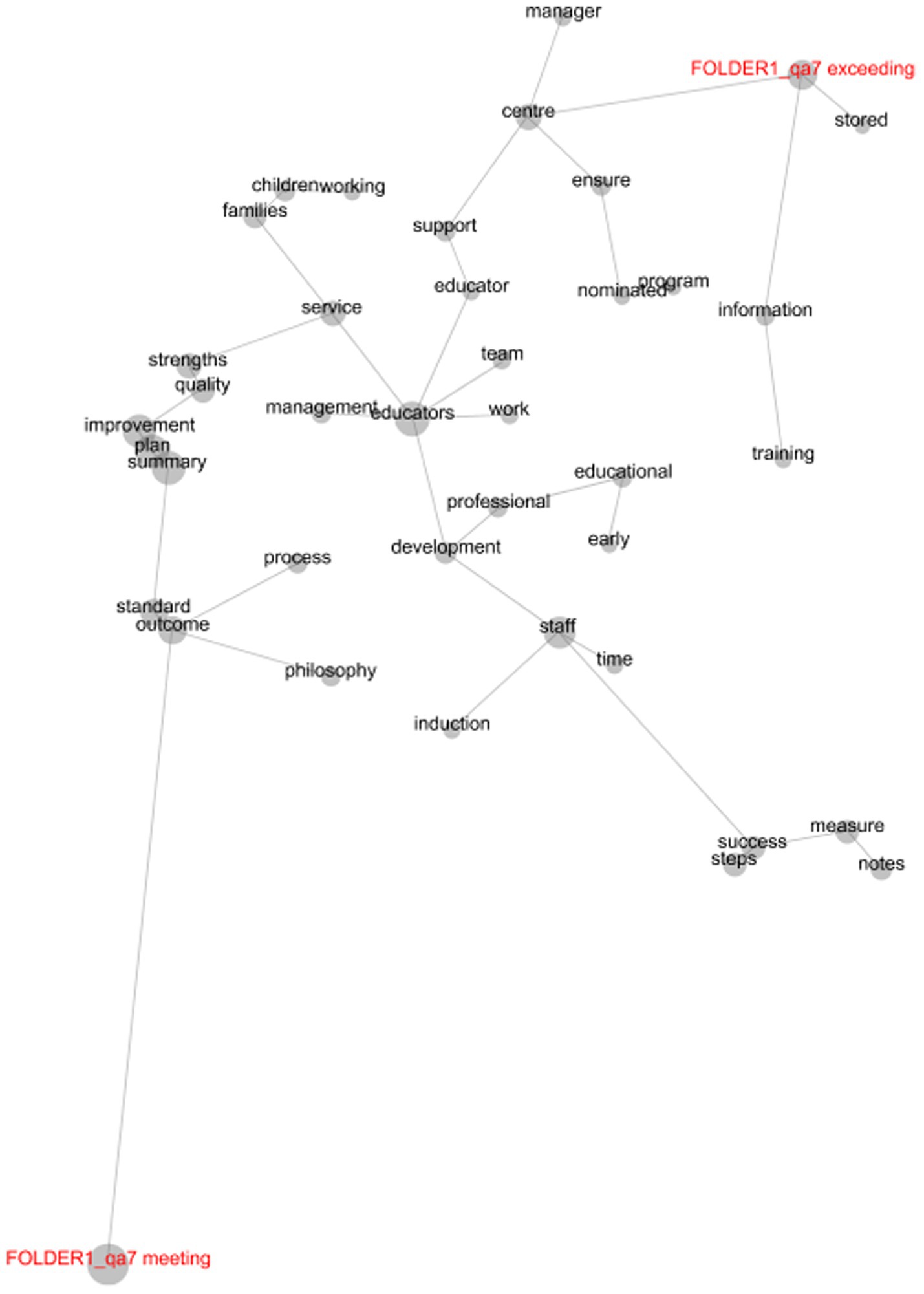
Figure 7. Concept map with highlighted pathways for QA7, comparison of one-step and two-step improvement services.
Exploration of the conceptual pathways led to the emergence of Figure 7. One-step (Meeting NQS) category QIPs seem more focused on the process of planning and meeting standards and outcomes. Educators and staff were connected to concepts of management, inductions and professional development. The focus of the two-step (Exceeding NQS) category QIPS was shown to be more systemic: co-location of concepts related to leadership roles within the centre and information themes (manager, nominated supervisor) (Figure 7) suggests that there was a greater awareness of how service management supported the work of educators than was evident amongst than one-step improver services.
4. Discussion and conclusion
This study sought to identify the factors which contributed to different levels of quality improvement in QA 1 (Educational Program and Practice) and QA 7 (Governance and Leadership) in ECEC services, as evidenced in the QIPs created by a representative sample of Australian LDC services. Leximancer 4.5 (Leximancer, 2018a) was used as a tool to analyze this documentary data. The QIP is a tool used to support the reflective planning and evaluation, and this evidence for intentional quality improvement. In this study the QIPs demonstrated how the sophistication of thinking about the QAs and how this related to practice, management, and leadership in the LDCs contributed to greater levels of improvement in the A&R process.
Leximancer 4.5 provides visual mapping of key information from the QIPs in different visualization styles. This mapping enabled us to find patterns that supported comparison of two sets of QIPs, from the one-step (Meeting NQS) category and the two-step (Exceeding NQS) category by using automated classification of content rather than any pre-determined coding.
There are limits to the generalizability of these findings because of the specific nature of the sample to the Australian context. Although this research was limited and contextual, with the QIPs provided to us by ACECQA, the selected documents provided a representative sample of LDC services across Australia. The direction of this research project necessitated that we were only investigating two of the seven quality areas from a select sample, as discussed previously. Nevertheless, the study also provided some more generalizable findings.
Conceptual visualizations for QA1 of the QIPs reported children’s learning and educator inputs were important concepts for improving quality. As can be seen in the mapping which showed the direct pathways between children, learning and educators. This showed staff, children, and families close to these concepts of children and learning indicating contributions to children’s learning in ECEC. It was clear that ECEC services which went from working toward to Meeting NQS (blue lines) placed more emphasis on the everyday routines and learning experiences. ECEC services increased their rating to Exceeding NQS (red lines), had different priorities and focused more on the educational leader moving beyond the routines and learning within the program. These educational leaders were supported by the management of the organization with additional time and support which suggests management and leadership within these organizations recognized the importance and significance of the educational leader’s role and pedagogical leadership in relation to program development and children’s learning found in research (Sims et al., 2017; Halttunen et al., 2019).
Concept visualizations of the QA 7 QIP provided a different focus, whereby concepts of educators, management, and professional development were found. In ECEC services which improved from working toward to Meeting NQS, the management of staff, as well as inductions and professional learning were located close to educators and staff. However, services which increased their rating to Exceeding had a more systemic approach. This encompassed how the service management and related information supported educators, with much stronger links to leadership roles involving the manager and/ or nominated supervisor, with concepts directly related to management roles, training, support, and information.
These research findings, using the representative sample of Australian ECEC services, show that quality improvement is the result of collaborative effort, and shared responsibility. The results emphasize the importance of leadership in service delivery to improve quality. Requiring organizational leadership, support, and resourcing for educators. Such commitment requires the recruitment and retention of qualified and skilled early childhood educators alongside, support for professional learning, resourcing of the learning environment and the creation of a positive work environment and conditions that promote and enable professional practice (Irvine et al., 2016; Cumming et al., 2021; McFarland et al., 2022). Organizational leadership and support are necessary to develop educator agency and decision-making thus supporting the quality within programs and practices (Howes et al., 2008; Mathers et al., 2012; LeeKeenan and Ponte, 2018). The ECEC services who made the leap to a two-step improvement to an Exceeding rating in both QA1 and QA7 demonstrated an awareness of the need to support and lead staff at all levels within the service. In particular, the role of the educational leader was highlighted in these services as an important and necessary role in leading learning and development in these areas, and ensuring this learning is visible in-service planning through the QIP.
Data availability statement
The original contributions presented in the study are included in the article/supplementary material, further inquiries can be directed to the corresponding author.
Author contributions
All authors listed have made a substantial, direct, and intellectual contribution to the work and approved it for publication.
Funding
This study was funded by Australian Children’s Education and Care Quality Authority.
Acknowledgments
This research was funded by the Australian Children’s Education and Care Quality Authority (ACECQA) who initiated an open tender process seeking the services of an external organisation to design and conduct a national research study to identify the characteristics and drivers of quality improvement in long day care services (Quality Improvement Research Project—Request for Tender, October 2018).
Conflict of interest
The authors declare that the research was conducted in the absence of any commercial or financial relationships that could be construed as a potential conflict of interest.
Publisher’s note
All claims expressed in this article are solely those of the authors and do not necessarily represent those of their affiliated organizations, or those of the publisher, the editors and the reviewers. Any product that may be evaluated in this article, or claim that may be made by its manufacturer, is not guaranteed or endorsed by the publisher.
References
Angus, D. (2014). Leximancer tutorial 2014. Available at: https://www.youtube.com/watch?v=F7MbK2AF0qQ.
Angus, D., Rintel, S., and Wiles, J. (2013). Making sense of big text: a visual-first approach for analysing text data using Leximancer and Discursis. Int. J. Soc. Res. Methodol. 16, 261–267. doi: 10.1080/13645579.2013.774186
Aubrey, C. A. (2019). What early childhood leadership for what kind of world? Contemp. Issues Early Child. 20, 65–78. doi: 10.1177/1463949119828145
Australian Children’s Education and Care Authority [ACECQA] (2012). National quality framework for early childhood education and care. [Online]. ACECQA. Available at: https://www.acecqa.gov.au/national-quality-framework (Accessed January 21, 2020).
Australian Children’s Education and Care Authority [ACECQA] (2016). Educational program and practice an analysis of quality area 1 of the National Quality Standard. Occasional paper 1 [Online]. ACECQA. Available at: https://www.acecqa.gov.au/sites/default/files/acecqa/files/Reports/OccasionalPaper1-EducationalProgramandPractice.pdf (Accessed January 21, 2020).
Australian Children’s Education and Care Authority [ACECQA] (2017). Leadership and management in education and care services. An analysis of quality Area7 of the National Quality Standard. Occasional paper 5 [Online]. ACECQA. Available at: https://www.acecqa.gov.au/sites/default/files/2018-02/OccasionalPaper5-LeadershipManagementEducationCareServices.PDF (Accessed January 21, 2020).
Australian Children’s Education and Care Authority [ACECQA] (2018). Quality rating reassessments: an analysis of quality improvement in education and care services 2013–2017. Occasional paper 6 [Online]. Available at: https://www.acecqa.gov.au/sites/default/files/2018-07/OccasionalPaper6_QualityRatingReassessments.pdf (Accessed January 23, 2020).
Australian Children’s Education and Care Authority [ACECQA] (2020). National Quality Standard [Online]. Available at: https://www.acecqa.gov.au/nqf/national-quality-standard/ (Accessed January 21, 2020).
Australian Children’s Education and Care Authority [ACECQA] (2023). About us. Available at: https://www.acecqa.gov.au/about-us (Accessed January 15, 2023).
Bowen, G. A. (2009). Document analysis as a qualitative research method. Qual. Res. J. 9, 27–40. doi: 10.3316/QRJ0902027
Carah, N., Meurk, C., and Angus, D. (2016). Online self-expression and experimentation as ‘reflectivism’: using text analytics to examine the participatory forum hello Sunday morning. Health 21, 119–135. doi: 10.1177/1363459315596799
Charmaz, K. (2006). Constructing grounded theory: a practical guide through qualitative analysis. London: Sage.
Cloney, D., Cleveland, G., Hattie, J., and Tayler, C. (2016). Variations in the availability and quality of early childhood education and care by socioeconomic status of neighborhoods. Early Educ. Dev. 27, 384–401. doi: 10.1080/10409289.2015.1076674
Corbin, J., and Strauss, A. (2008). Basics of Qualitative Research: Techniques and Procedures for Developing Grounded Theory (3rd ed.). Thousand Oaks, CA: Sage.
Council of Australian Governments [COAG] (2009). National partnership agreement on the national quality agenda for early childhood education and care. [Online]. Available at: http://www.federalfinancialrelations.gov.au/content/npa/education/national-partnership/National-Quality-Early-Childhood-Education-2018-NP.pdf (Accessed January 20, 2020).
Crofts, K., and Bisman, J. (2010). Interrogating accountability: an illustration of the use of Leximancer software for qualitative data analysis. QRAM 7, 180–207. doi: 10.1108/11766091011050859
Cumming, T., Wong, S., and Logan, H. (2021). Early childhood educators’ well-being, work environments and ‘quality’: possibilities for changing policy and practice. AJEC 46, 50–65. doi: 10.1177/1836939120979064
Davis, B., and Dunn, R. (2018). Making the personal visible: emotion in the nursery. Early Child Dev. Care 188, 905–923. doi: 10.1080/03004430.2018.1439487
Glaser, B., and Strauss, A. (1967). The discovery of grounded theory. Hawthorne, NY: Aldine Publishing Company
Halttunen, L., Sims, M., Waniganayake, M., Hadley, F., Bøe, M., Hognestad, K., et al. (2019). “Working as early childhood centre directors and deputies – perspectives from Australia, Finland and Norway” in Leadership in early education in times of change: Research from five continents. eds. P. Strehmel, J. Heikka, E. Hujala, J. Rodd, and M. Waniganayake. 1st ed (Berlin, Germany: Verlag Barbara Budrich), 231–252.
Hard, L., and O'Gorman, L. (2007). Push-me or “pullyou”? An opportunity for early childhood leadership in the implementation of Queensland’s early years curriculum. Contemp. Issues Early Child. 8, 50–60. doi: 10.2304/ciec.2007.8.1.5
Harrison, L. J., Waniganayake, M., Brown, J., Andrews, R., Ly, H., Hadley, F., et al. (2023). Structures and systems influencing quality improvement in Australian early childhood education and care centres. Aust. Educ. Res., 1–23. doi: 10.1007/s13384-022-00602-8
Howes, C., Burchinal, M., Pianta, R., Bryant, D., Early, D., Clifford, R., et al. (2008). Ready to learn? Children's pre-academic achievement in pre-kindergarten programs. Early Child Res. Q. 23, 27–50. doi: 10.1016/j.ecresq.2007.05.002
Hyndman, B., and Pill, S. (2018). What's in a concept? A Leximancer text mining analysis of physical literacy across the international literature. Eur. Phys. Educ. Rev. 24, 292–313. doi: 10.1177/1356336X17690312
Irvine, S., Thorpe, K., McDonald, P., Lunn, J., and Sumsion, J. (2016). Money, love and identity: initial findings from the national ECEC workforce study. Brisbane, QLD: Queensland University of Technology.
LeeKeenan, D., and Ponte, I. C. (2018). Meaningful assessment and documentation: how directors can support teaching and learning. YC Young Child 73, 87–92.
Mathers, S., Singler, R., and Karemaker, A. (2012). Improving quality in the early years: a comparison of perspectives and measures. Oxford: University of Oxford.
McFarland, L., Cumming, T., Wong, S., and Bull, R. (2022). “‘My cup was empty’: the impact of Covid-19 on early childhood educator well-being” in The impact of COVID-19 on early childhood education and care: International perspectives, challenges, and responses. eds. J. Pattnaik and M. R. Jalongo (Cham: Springer International Publishing)
McKenna, B., Myers, M. D., and Newman, M. (2017). Social media in qualitative research: challenges and recommendations. Inf. Organ. 27, 87–99. doi: 10.1016/j.infoandorg.2017.03.001
Millei, Z., and Sumsion, J. (2011). The 'work' of community in belonging, being and becoming: the early years learning framework for Australia. Contemp. Issues Early Child. 12, 71–85. doi: 10.2304/ciec.2011.12.1.71
Organisation for Economic Cooperation and Development [OECD] (2015). Starting strong IV: monitoring quality in early childhood education and care [Online]. Paris: OECD Publishing.
Parsons, R., and McKenna, B. J. (2005). “Constructing social responsibility in mining company reports” in International conference on critical discourse analysis: theory into research. ed. T. Le (Launceston, TAS: UTAS Faculty of Education, University of Tasmania)
Poser, C., Guenther, E., and Orlitzky, M. (2012). Shades of green: using computer-aided qualitative data analysis to explore different aspects of corporate environmental performance. JoMaC 22, 413–450. doi: 10.1007/s00187-011-0147-2
Roberts, P. (2017). A curriculum for whom? Rereading 'Implementing the Australian curriculum in rural, regional, remote and distance-education schools' from a rural standpoint. AIJRE 27, 43–61. doi: 10.47381/aijre.v27i1.108
Rodd, J. (2013). Leadership in early childhood: the pathway to professionalism. Crows Nest, NSW: Allen & Unwin.
Rooney, D., McKenna, B., and Barker, J. R. (2011). History of ideas in management communication quarterly. MCQ 25, 583–611. doi: 10.1177/0893318911405623
Sims, M., Waniganayake, M., and Hadley, F. (2017). Educational leadership in early childhood settings in Australia – an evolving role. Educ. Manag. Adm. Leadersh. 46, 960–979. doi: 10.1177/1741143217714254
Smith, A. E., and Humphreys, M. S. (2006). Evaluation of unsupervised semantic mapping of natural language with Leximancer concept mapping. Behav. Res. Methods 38, 262–279. doi: 10.3758/BF03192778
Sotiriadou, P., Brouwers, J., and Le, T.-A. (2014). Choosing a qualitative data analysis tool: a comparison of NVivo and Leximancer. Ann. Leis. Res. 17, 218–234. doi: 10.1080/11745398.2014.902292
Spry, D., and Dwyer, T. (2017). Representations of Australia in South Korean online news: a qualitative and quantitative approach utilizing Leximancer and Korean keywords in context. Qual. Quant. 51, 1045–1064. doi: 10.1007/s11135-016-0387-1
Sumsion, J., and Wong, S. (2011). Interrogating ‘belonging’ in belonging, being and becoming: the early years learning framework for Australia. Contemp. Issues Early Child. 12, 28–45. doi: 10.2304/ciec.2011.12.1.28
Torii, K., Fox, S., and Cloney, D. (2017). Quality is key in early childhood education in Australia. Mitchell Institute Policy Paper No. 01/2017. (Melbourne, VIC: Mitchell Institute).
Tseng, C., Wu, B., Morrison, A. M., Zhang, J., and Chen, Y.-C. (2015). Travel blogs on China as a destination image formation agent: a qualitative analysis using Leximancer. Tour. Manag. 46, 347–358. doi: 10.1016/j.tourman.2014.07.012
Urquhart, C. (2013). Grounded theory for qualitative research: a practical guide. London: Sage Publications Ltd.
Keywords: quality, improvement, Australia, regulation, early childhood education
Citation: Davis B, Dunn R, Harrison LJ, Waniganayake M, Hadley F, Andrews R, Li H, Irvine S, Barblett L and Hatzigianni M (2023) Mapping the leap: differences in quality improvement in relation to assessment rating outcomes. Front. Educ. 8:1155786. doi: 10.3389/feduc.2023.1155786
Edited by:
Virginia Barba-Sánchez, Universidad de Castilla-La Mancha, SpainReviewed by:
Wendy Boyd, Southern Cross University, AustraliaLouise Tracey, University of York, United Kingdom
Copyright © 2023 Davis, Dunn, Harrison, Waniganayake, Hadley, Andrews, Li, Irvine, Barblett and Hatzigianni. This is an open-access article distributed under the terms of the Creative Commons Attribution License (CC BY). The use, distribution or reproduction in other forums is permitted, provided the original author(s) and the copyright owner(s) are credited and that the original publication in this journal is cited, in accordance with accepted academic practice. No use, distribution or reproduction is permitted which does not comply with these terms.
*Correspondence: Belinda Davis, belinda.davis@mq.edu.au
 Belinda Davis
Belinda Davis Rosemary Dunn1
Rosemary Dunn1  Linda J. Harrison
Linda J. Harrison